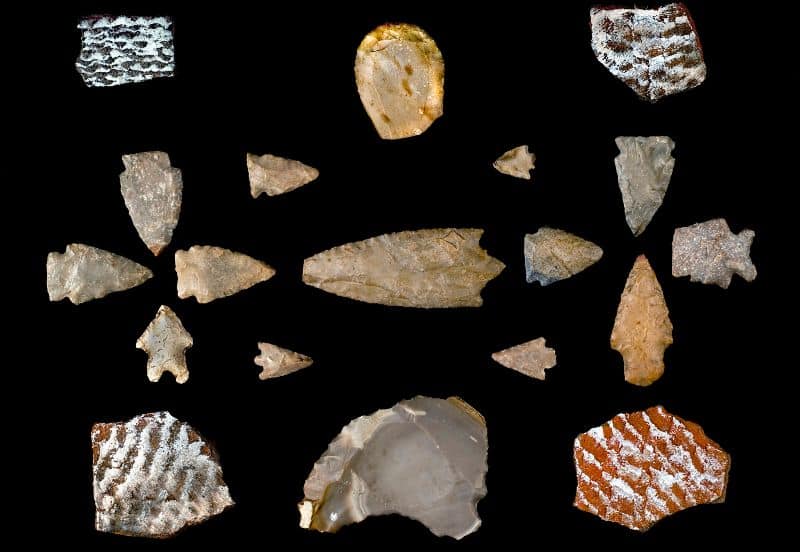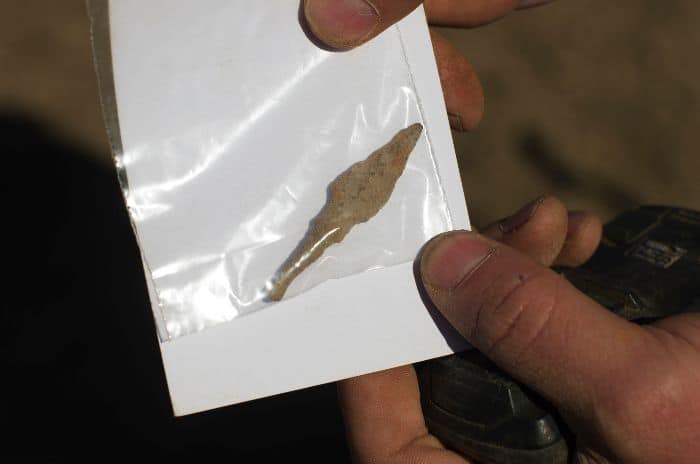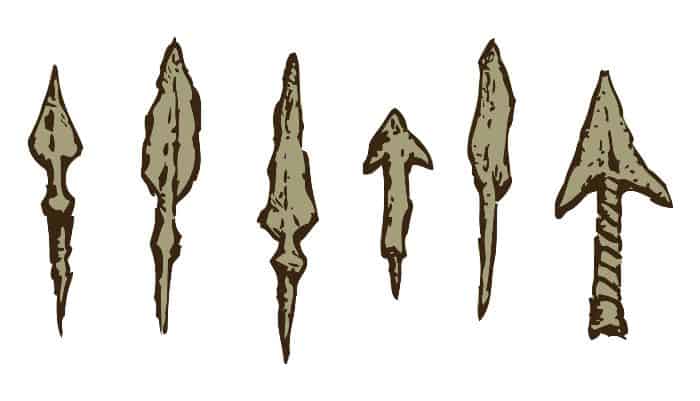
Detectorists aren’t only interested in highly valuable metals like gold, some of them (including me) are interested in old arrowheads artifacts as well!
Of course, these not only hold some value but also will serve great for antique objects collectors.
Now, the challenge is whether it is possible to find arrowheads or not and how you can find them.
This article provides helpful insights …
Can metal detectors actually find arrowheads?
In general, metal detectors cannot find most arrowheads directly as they are mainly made up of different stones, such as flints, obsidian, or chert …
However, there are some rare arrowheads that are made of metals (partially or entirely) such as copper. In such a case most metal detectors can pretty easily find them.
How can metal detectors still help finding arrow?
Generally old arrowheads made out of stones are the ones that hold the most historical (eventually monetary) value. Since detectors are really able to pick them up, so that would be problematic, right?
Indeed, your beloved machine can still help you find them pretty indirectly as far as you are targeting the right places. Chances finding old relics (especially old coins) is a solid indicators are you are probably close to old arrows.
Tip 1: Generally, a good metal detecting practice is to dig to a minimum just to recover your target before returning the hole as is, BUT in this case, you should digger bigger holes with the hope of finding an arrow around.
Tip 2: You also need to lower the discrimination level so you can dig up a more than usual. Of course expect to dig more trash but it is definitely worth it in this case.
Tip 3: You don’t have to use a fancy metal detector to be successful, indeed you can do just Fine even with an entry-level model like this quality detector.
Where can you find arrowheads in general?

You need to do some homework to research different indigenous tribes, their …
- Lifestyle
- Habits
- Culture
- And customs
By this you can recognize what sort of artifacts to expect and what type of material was existent in the areas they stayed in.
Keep in mind that there are more than 574 federally recognized Indian nations in the USA. Their location is scattered in different states, whereas 229 of them were located in Alaska.
Native American tribes were seasonally nomadic. They would move to distant places during summer or winter and settle in camps.
They would look for suitable places for fishing, hunting, or planting crops during summertime, usually to higher elevations.
Conversely, during winter, they would migrate to lower altitudes that can help them survive the cold.
There are also some short-term campsites, most of which were set up for festivals, tribe meetings, or even seasonal sustenance.
- Long-term campsites can be great potential locations to find arrowheads
- Whereas short-term campsites can be nice for finding some dainty pieces and artifacts.
Camps were mostly located near a water source, such as creeks, lakes, ponds, or rivers…
Clean, shallow water sources and nearby places could be great to find arrowheads, especially those which have been recently cleared or dried up. Old swamps or sandy loam areas can also be potential sites.
When you are vising such places, don’t forget to ask the local people as they can direct you to the best locations! You can also read this book that provides a detailed guideline for surface collectors to find arrowheads.
As mentioned before, metal detectors are often used to find relics. These relics could be coins, jewelry, knife blades, needles, harpoons, breastplates, etc. So, when a relic hunter is exploring a site, a metal detector can certainly map out an area where Indian artifacts can be found.
Thus, even though the metal detector cannot detect most arrowheads, it may lead you to the area, where there is a possibility to find arrowheads.
Time and season are critical factors for the successful exploration of artifacts …
Early spring is the best time for arrowhead hunting, particularly after rainfall or a flood. This is because the surface layers of the soil would be washed away and different debris and artifacts would be easily exposed.
After harvesting, fields would also be great to explore at places of former Indian settlements.
When you are hunting for arrowheads, you must know what you are looking for. You can learn about different stones and how they look like from online research or museums.
Besides, you can train your eyes to identify those pointy arrowheads. Sharp edges, flaked surfaces, or distinct shapes can distinguish arrowheads from regular stones. Distinct colors of some arrowheads can also help to spot them, for example, the obsidian stone has a darker appearance, sometimes even black.
Is it True that all creeks have arrowheads?
Creeks are popular spots to hunt for arrowheads. Looking for arrowheads in creeks is best done in the upper portions, where ground erosion happen quickly.
However, not all creeks will have arrowheads in them. You need to do your research and detect around creeks where you know there were settlements in the past.
If there were no tribes living nearby the creek, it is highly unlikely that you will find arrowheads at the creek.
How deep are arrowheads usually buried?
You don’t always have to dig to find arrowheads. Sometimes you just have to wait for soil erosion to bring the arrowhead to the surprise.
It is important to know that most arrowhead hunters discourage digging for arrowhead because first, you need to obtain fool-proof permission to dig a site, and then, you are likely already on sacred ground or you could be disturbing a burial site of the tribes.
What is the composition of arrowheads?
Most arrowhead artifacts found in the United States were made by the Native American Indians during the Stone Age.
The arrowheads were supposed to be sufficiently strong, shapeable to be sharp, and lightweight enough to fly. That is why they chose stones or materials that can be easily chipped and sharpened.
Most arrowheads are made of specific stones like quartz, jasper, obsidian, chert, agate, chalcedony, basalt, etc. They can also be made up of organic materials like clams, oyster shells, animal bone, natural wood, or petrified wood. None of these materials can be detected by a metal detector.
During the Stone Age, Native American Indians did not know how to smelt or shape metals. The best material they could use was some naturally occurring metal nuggets, mostly copper.
Again, copper was considered the symbol of wealth among them. Therefore, only a few artifacts, which belonged to those rich Indians would contain metal.
Later on, when the Indians came in contact with the Europeans, they gradually learned to use steel and other metals. Metal arrowheads and spearheads can be easily found by metal detectors.
How to identify arrowhead accurately?

If you are a beginner at arrowhead detecting, you might think that it is difficult to spot the difference between a rock and an arrowhead …
After all, many arrowheads are made from stones. So how to tell the difference? All you have to do is to look for a point, a base, and an edge.
Identifying different arrowheads involves looking at its edges or the presence or absence of a notch on the base.
There are eight different common shapes of arrowheads that have been identified.
- Auriculate: This type of arrowhead looks like a fish and includes “ears” or auricles pointing downwards.
- Lanceolate: This type of an arrowhead has a concave, convex or straight base and does not have notches or shoulders.
- Corner notched: Derived from its name, this arrowhead has corner notches on its base
- Side-notched: Towards the end base of this arrowhead, there are side notches intended for hafting.
- Stemmed: This arrowhead’s stems can either be long or short, contracting or expanding. All stemmed arrowheads have shoulders.
- Stemmed-bifurcated: The base of this arrowhead bifurcates or splits into two.
- Basal-notched: There are notches formed at the base of this arrowhead.
- Arrow points: This type of arrowhead is generally shaped like a thin triangle and is usually small.
How to recognize an arrowhead overall value?
An arrowhead can be priced between $10 and $20. The Official Overstreet book will provide a valuation guide for your arrowhead. Despite the listings found on the guide, it can be challenging to find a dealer willing to pay a high price for an arrowhead.
Though the general price for common arrowheads may not be that much, there is still a chance for an arrowhead to fetch thousands of dollars, especially if it’s rare and comes in excellent condition free from cracks and chips. Many arrowheads have value and can be worth good money, it you have an authentic one.
What is the most valuable arrowhead ever found?
The most expensive arrowhead ever found was the Rutz Clovis Point, which was sold to a Texas collector at a 2013 auction for $276,000.
Final Thoughts …
I really hope you’ve learnt something new in this article, now I believe you should actually get started , do some research on places you need to target and plan your next hunt as soon as possible …
Don’t expect to come across arrows in your first hunt, not even in your first couple hunts. However, once you find your first arrow, then you will develop a sold sense and ability to find even more. That’s when the real fun actually starts …
